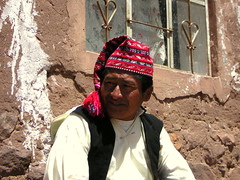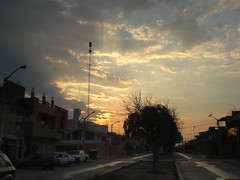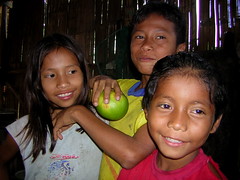Taquile
This narrow cigar-shaped island has been inhabited for almost 10,000 years, and in that time life has remained mostly the same. The 1000 or so population still farm the ancient terraces and keep alive their traditional customs. There are no cars and no electricity.
 Speaking of their traditional clothes, the islanders textiles are regarded being the finest made in Peru. The men wear embroidered waistbands that take anywhere from 6 months to a year to complete. They depict calenders and histories with images in fine detail, although these are difficult for outsiders to interpret.
Speaking of their traditional clothes, the islanders textiles are regarded being the finest made in Peru. The men wear embroidered waistbands that take anywhere from 6 months to a year to complete. They depict calenders and histories with images in fine detail, although these are difficult for outsiders to interpret.
You can also tell a lot about a persons status by their clothes.
- A man in all black with a colourful chuyo, with a black hat on top of that, is a leader on the island.
- A man, often young, with a chuyo half-white and half-red is unmarried.
- An unmarried man with a half-red chuyo with the top flipped to the right has a girlfriend, flipped to the left he does not.
- A married man has an all-red chuyo often with the top put to the back or there abouts.
- A single woman has a long skirt of many colours and layers.
- A single woman with a boyfriend hitches one skirt and pins it higher.
- A married woman wears a less-colourful, more red skirt.
The island makes most of its income from textiles, some of which happens to be bought by tourists who venture to the island. None of this was bought by me however, the weaving is so good that all items cost much more than I could afford. What I could afford were one of the little colourful wristbands that the little girls sell to tourists in the plaza. Despite having this job since being able to walk they are incredibly shy and it is near impossible to hear what they say to ask you to buy it. Engaging them in conversation leaves them wincing and looking away.
The island’s community works by a system of collectivism that stresses social and economic interdependence. Every penny made helps every islander and everyone gets a share of the harvest. For this to function and ancient Andean and Inca code applies – do not steal, do not lie, do not be lazy. These were the only 3 laws that ran the Inca empire and run Taquile.
We spent a few hours on the island, during which time we wandered the small streets and ate some trucha fish. We encountered a small boy alone on some steps and asked him his name.  His Spanish was poor and we were not sure if he understood, and we didn’t understand what his name was. We walked 10 or 20 minutes more and ended up coming back a similar way, and here we found him again, still alone. We asked him where is mother was, he seemed to understand and replied “No hay”, literally there is not one. We assume he meant to say she is not here, he would be a native Quechua speaker, and at not more than a couple of years old wouldn’t be very good at speaking that either. We asked him where he was going and he pointed to the distance and said “allá”, there. We asked if he would like us to accompany him, and with a nod of agreement, off we went with our new friend to there. Slowly and confidently he walked up the dirt street with us to his side before we arrived at a small restaurant, where we assume he lived or at least had come to visit for a nice afternoon meal. We said goodbye and parted ways.
His Spanish was poor and we were not sure if he understood, and we didn’t understand what his name was. We walked 10 or 20 minutes more and ended up coming back a similar way, and here we found him again, still alone. We asked him where is mother was, he seemed to understand and replied “No hay”, literally there is not one. We assume he meant to say she is not here, he would be a native Quechua speaker, and at not more than a couple of years old wouldn’t be very good at speaking that either. We asked him where he was going and he pointed to the distance and said “allá”, there. We asked if he would like us to accompany him, and with a nod of agreement, off we went with our new friend to there. Slowly and confidently he walked up the dirt street with us to his side before we arrived at a small restaurant, where we assume he lived or at least had come to visit for a nice afternoon meal. We said goodbye and parted ways.
On leaving the island we had to go down hundreds of steps to reach the dock from the town in the center. Here we saw dozens of locals making the horrendous journey up to the steps to the town with supplied brought in, probably from Puno. Little old ladies were climbing hundreds of these steps with more weight on their backs than I could possibly carry on flat even-ground. Apparently they make this journey each and everyday, and the biggest medical problem on the island is back-pain.
More photos below.
Tags: chullo, lake titicaca, taquile









